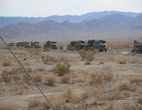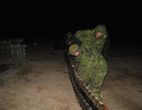By Tpr Foster
1 February 2010
On the morning of January 5th, A Sqn TFA 1-10 departed for the National Training Center (NTC) in Ft. Irwin, California. It was a nice climate change from chilly Edmonton. The temperature rose as high as 20°c in the day and averaged 6°c at night. Once we were settled in Camp RUBA, located on the outskirts of the Ft. Irwin Garrison, maintenance began on the tanks to prepare for the exercise ahead. It wasn't long before the tanks were low bedded to FOB RENO. FOB RENO would be our home in the desolate desert for the next month. Once there, maintenance continued and the implements were mounted on the tanks. A Sqn began supporting the infantry through the Level 3.5 live fire exercises.
On January 14th, the Sqn headed to EREBAT-SHAR, a simulated Afghan village, to partake in the Urban Mounted Patrol stand training. This stand saw the Sqn acting in a mechanized infantry role for the purpose of battle indoctrination and to exercise first aid and casualty scene management skills. The stand is designed to overwhelm soldiers and push them to their limits. The village was populated by actors hired to play Afghan people. They looked and dressed the part and they spoke Afghan languages. Once the first scenario kicked off, the village came to life as the convoy passed through. It wasn't far into the village before the convoy was stopped by an IED strike. Shortly afterward the town became a scene of chaos with RPG fire, injured civilians and soldiers, gunfire, and angry and frightened civilians. Great effort was made to make the situation seem as real as possible. Some of the actors were actually amputees with Hollywood quality makeup effects. RPG fire was simulated with small rockets on thin wires strung between buildings. The pyrotechnics were also very loud and convincing. A Canadian soldier was captured and taken to a nearby building. There he was video taped on his knees with his arms bound behind him. Angry mobs kept soldiers on their toes as they pushed through cordons and overwhelmed injured troops who were receiving first aid. After a detailed After Action Review (AAR) with photos and video footage, the soldiers were visited by the Strathcona's RSM (CWO Joe Ramsay) and the CO (LCol Derek Macaulay) before preparing to launch for a second run through the scenario. The second scenario was just as hectic as the first but saw the Sqn take a different route in and get trapped deeper within the village.
A Sqn returned to FOB RENO to continue participating in the Level 3.5 live fire exercises. The 3.5 saw infantry securing and clearing a village with the aid of engineers, OLMT with ANA role players, a FOO/FAC, and a CIED team. The tanks lead the group to the village with the roller tank and then provided a cordon, preventing the insurgents from reinforcing the village.
On January 20th, the Level 5 (Combat Team) live fire exercises began. The Level 5 saw an infantry company, A Sqn, OMLT, and engineers, working together to clear 3 villages. Also supporting the combat team was a FOO/FAC coordinating live artillery fire and CF-188's armed with 500lbs and 2000lbs bombs as well as surveillance pods. The terrain for the Level 5 was very similar to that of Afghanistan. It provided excellent cover for mines, IEDs, and IED trigger men. Canadian snipers provided over watch and current information on the enemy's activities. A Sqn lead the combat team to the objectives. This involved rolling leaguers and breaching a tank ditch, a mine field, and a grape field. As the infantry, OMLT, and engineers cleared the villages, tanks provided a cordon to thwart a counter attack. A Sqn impressed many with precision and accurate fire as well as well planned tactical movement. Equally impressive many was the number of running and gunning tanks the Sqn provided for the range, while at the same time, still supporting the Level 3.5.
The Sqn worked long hours maintaining the tanks. The hard work resulted in great success. Since the beginning of the exercise, nearly all of the A Sqn tanks were fully operational and continued to be so as they were used nearly every day. Training at the NTC has proved a valuable asset in preparing us for our upcoming mission in Afghanistan.




